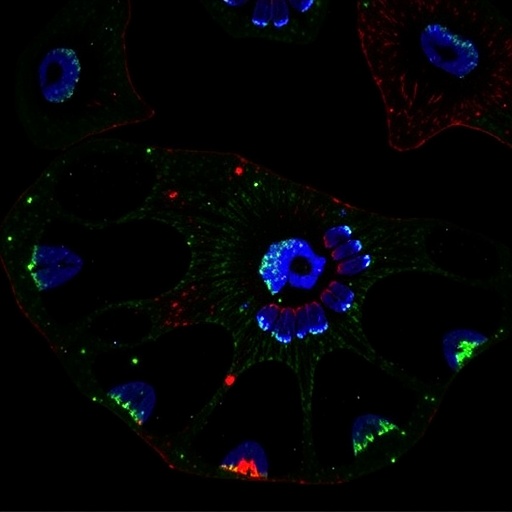In an era where healthcare technology is evolving at an unprecedented pace, the integration of artificial intelligence (AI) into clinical practices has become not just beneficial, but, in many cases, essential. A notable advancement in this field is the development of a state-of-the-art non-contact AI system designed specifically for monitoring unplanned device removal in neurocritical care settings. This cutting-edge system, as elucidated by researchers Shi, Z., Huang, H., and Shi, T., serves as a promising solution to a challenge that has long plagued healthcare professionals: the unintended dislodgment of critical devices from patients.
Neurocritical care environments are inherently high-stakes, often treating patients with severe neurological conditions who are connected to a myriad of monitoring devices and interventions. The removal of these devices, whether accidental or intentional, can lead to significant deterioration in a patient’s condition, prompting urgent medical interventions that could be avoided. With this backdrop, the introduction of an AI-driven system fortified with non-contact monitoring capabilities aims to enhance patient safety and streamline clinical workflows.
At the heart of this innovative technology lies an advanced algorithm capable of recognizing normal versus abnormal patient behavior and identifying when devices are compromised. Using machine learning techniques, the system has been trained on vast datasets populated with a variety of patient behaviors, equipping it to discern even minor deviations that may indicate potential risks. This capability positions the system not merely as a monitoring tool, but as a proactive safeguard against complications arising from unplanned device removal.
One of the most significant features of this AI system is its non-contact nature. Traditional monitoring methods often rely on physical sensors or cameras that pose privacy concerns and may introduce additional logistical challenges. By utilizing non-invasive technology, this system ensures that patient dignity and comfort remain paramount. Additionally, the non-contact approach minimizes the risk of introducing infection—a critical consideration in the care of vulnerable neurocritical patients.
The researchers undertook extensive evaluations of the system’s efficacy, employing a series of trials within neurocritical care units. Preliminary findings have indicated an impressive accuracy rate in detecting incidents of unplanned device removal, outperforming conventional monitoring techniques. This data serves to not only validate the technology but also underscores the substantial potential for AI applications across diverse healthcare settings.
Moreover, the implications of this AI system extend beyond immediate patient safety. By proactively reducing the incidence of device removal-related complications, healthcare facilities may anticipate lower rates of extended hospital stays and decreased healthcare costs associated with emergency interventions. In an industry perpetually striving for cost-effectiveness, such advancements could herald a new era in patient care management.
In light of the rapidly advancing nature of AI in medicine, ethical considerations around patient data privacy and technology dependence are increasingly relevant. The researchers have emphasized the importance of continuous oversight and regulation in the deployment of AI tools within clinical settings. Transparency in how data is managed and utilized must remain a core principle to foster trust between healthcare providers, patients, and technology developers.
Feedback from healthcare professionals who were able to observe the system in action has been overwhelmingly positive. Many have expressed appreciation for the additional layer of security provided by the AI system, noting how it has alleviated some of the pressures associated with patient monitoring in intense care environments. This integration of advanced technology allows for enhanced focus on patient-centered care, potentially improving overall outcomes.
Despite the promising developments surrounding this AI system, challenges remain in terms of widespread implementation. Adopting new technologies in clinical settings often encounters obstacles such as costs, training requirements, and resistance to change from established practices. It is vital that stakeholders in healthcare—ranging from administrators to frontline staff—collaborate to ensure that the transition to AI-enhanced monitoring systems is as smooth and beneficial as possible.
As this AI technology moves closer to being deployed in real-world settings, the educational component must not be overlooked. Training programs need to be developed to equip healthcare teams with the necessary skills to work alongside this technology effectively. Emphasizing adaptability and resilience within clinical teams will be essential as they integrate AI systems into their daily routines.
In summary, the development of a non-contact AI system for monitoring unplanned device removal in neurocritical care marks a pivotal step forward in the pursuit of enhanced patient safety and care outcomes. Grounded in innovative technology and backed by rigorous research, this system addresses a significant healthcare challenge while aligning with the growing trend towards digital integration in medicine. As the healthcare landscape continues to evolve, such systems could fundamentally change the way critical care is delivered, providing avenues for higher quality care and better patient experiences.
In conclusion, the potential of AI systems in healthcare is vast, but it will require collective efforts from all stakeholders to unlock their full capability. By forging partnerships between technologists and healthcare professionals, the sector can ensure that AI tools serve as allies in patient care, rather than obstacles in the pursuit of excellence.
Subject of Research: Non-contact AI system for monitoring unplanned device removal in neurocritical care.
Article Title: Design and evaluation of a non-contact AI system for monitoring unplanned device removal in neurocritical care.
Article References:
Shi, Z., Huang, H., Shi, T. et al. Design and evaluation of a non-contact AI system for monitoring unplanned device removal in neurocritical care.
BMC Nurs 24, 1247 (2025). https://doi.org/10.1186/s12912-025-03893-1
Image Credits: AI Generated
DOI: 10.1186/s12912-025-03893-1
Keywords: AI in healthcare, neurocritical care, patient monitoring, non-contact technology, device removal, patient safety, artificial intelligence, healthcare technology.
Tags: advanced algorithms in monitoringAI-driven patient monitoring systemsartificial intelligence for healthcareclinical workflow optimizationcritical device dislodgment preventionhealthcare technology advancementsmachine learning in clinical settingsNeurocritical Care Innovationsneurological condition managementnon-contact AI monitoringpatient safety technologyunplanned device removal in healthcare





